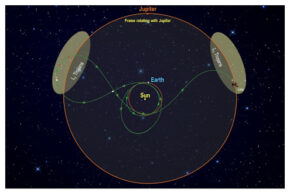In news- NASA’s Lucy mission is scheduled to take off on October 16.
About the mission-
- The Lucy mission is a 12-year journey making it NASA’s longest mission so far.
- This is the first spacecraft to explore Jupiter’s Trojan asteroids, and also the first to examine multiple independent solar system targets.
- The mission takes its name from the fossilized human ancestor (called “Lucy” by her discoverers) whose skeleton provided unique insight into humanity’s evolution.
- It will launch aboard an Atlas V 401 rocket.
- Scientists will use Lucy’s black and white cameras to count the number of craters on asteroid surfaces which will let them learn about the environments that the asteroids were exposed to billions of years ago.
- It will complete a 12-year journey to eight different asteroids — a Main Belt asteroid and seven Trojans.
- The spacecraft will first fly by earth twice and use the planet’s gravity to push itself toward the Trojans and will reach them by August 2026.
- Its journey is expected to end in two ways – come back to earth as an artefact or be flung into the sun or out of the solar system by Jupiter.

What are Trojan asteroids?
- They are named after characters from Greek mythology.
- They are described as clusters of rock grains and exotic ices that didn’t become planets when the solar system formed.
- Hence they are considered the best evidence left to learn more about the solar system’s formation.
- They circle the sun in two swarms where one precedes and the other follows Jupiter in its orbit of the sun.
- Clustered around the two Lagrange points equidistant from the Sun and Jupiter, the Trojans are stabilized by the Sun and its largest planet in a gravitational balancing act.
- All of the Trojans are thought to be abundant in dark carbon compounds.
Below an insulating blanket of dust, they are probably rich in water and other volatile substances.
















